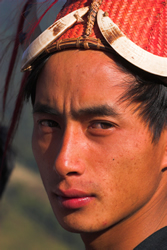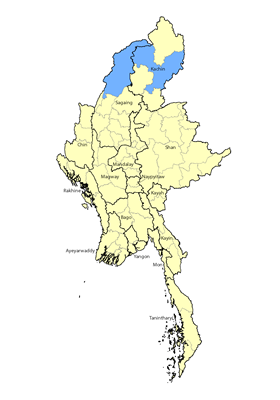The Cyampang (also spelled Champhang) are a tribe within the cluster of 49 similar groups profiled in Operation Myanmar. Although some people may find it nonsensical to profile such a small group, to God they are precious, and He has worked to redeem their culture. Tellingly, this tribe views itself as distinct and are proud of their ethnic identity. The Cyampang people have never previously appeared on any lists of the world's people groups.
Location: Despite having a tiny population of only 400 people, the Cyampang tribe of northwest Myanmar possess a distinct ethnic identity and speak their own dialect. The Cyampang are located on both sides of the border between Sagaing Region and Kachin State. A research team that visited the area in 2012 surveyed 130 Cyampang people. A total of 22 families lived in the ethnically diverse Pangsau Town in Sagaing Region, specifically in the villages of Lunglong (12 households) and Khamkeik (10 homes). An additional 15 families live about 100 miles (162 km) away in neighboring Kachin State, near the town of Shinbwiyan. A small Cyampang community also lives in northeast India, where their name is rendered “Thamphang.”
Language: Cyampang, which is part of the Naga branch of the Tibeto-Burman linguistic family, is a dialect within a small cluster of several related dialects that scholars have labeled “Ole.” Although similarities between the Ole varieties have been identified, mutual intelligibility is not always high due to differences in vocabulary,2 and individuals from different tribes often have to revert to Burmese in order to have a conversation. In India, the Cyampang people are often viewed as part of the Haqkhun tribe, “although both languages are very different from each other. Cyampang speakers can speak Haqkhun but not vice-versa.”
Most of them and the wider circle of Naga-related tribes in Myanmar claim to have lived in the country at least 500 years, while others claim an even longer history. For much of their existence, these tribes have battled for survival, with regular conflict erupting between them and ruling ethnic groups. A historical summary notes: “In the early 13th century, the Shan chief Sukhapa subjugated the Nagas, treating them poorly, while their dealings with the Ahom of Assam fluctuated between hostility and friendliness in the 16th century. In 1832, the King of Manipur marched through Naga territory and established some control over the region. Under the British, a further attempt was made to bring them under outside control, resulting in inter-village raids and headhunting expeditions being stamped out in the administered area.”
Most people lead simple lives hunting, fishing, and growing food, and for generations they have made their own traditional clothing. Weaving is considered “one of the most important industries, and their cloth is famous throughout Myanmar for its variety of colors and design. In many villages, home-grown cotton is used, although thread is often imported from India.”
Approximately 80 percent of Cyampang people are professing Christians today. They were part of a vast wave of religious conversions occurring from the 1950s to the 1990s that powerfully transformed them and Naga tribes. A small number of Cyampang families living in Kachin State have converted to Buddhism due to the greater Buddhist influence in the area.
Although most Cyampang people believe in Jesus Christ, no part of the Bible exists in a language they can easily understand. This lack of God's Word has stunted their spiritual growth, although visiting preachers do their best to encourage and teach the believers. The Shecyu New Testament exists, but the Shecyu dialect shares only a 56% lexical similarity with Cyampang, meaning that almost half the words in the Shecyu Bible are meaningless to a Cyampang person. The Cyampang and many other groups desperately need access to the Scriptures in their own languages and dialects.
Scripture Prayers for the Cyampang in Myanmar (Burma).
| Profile Source: Asia Harvest Copyrighted © Used with permission |











